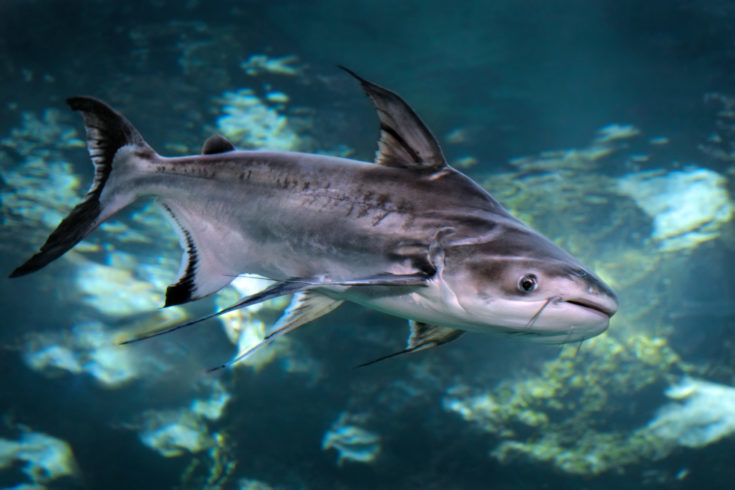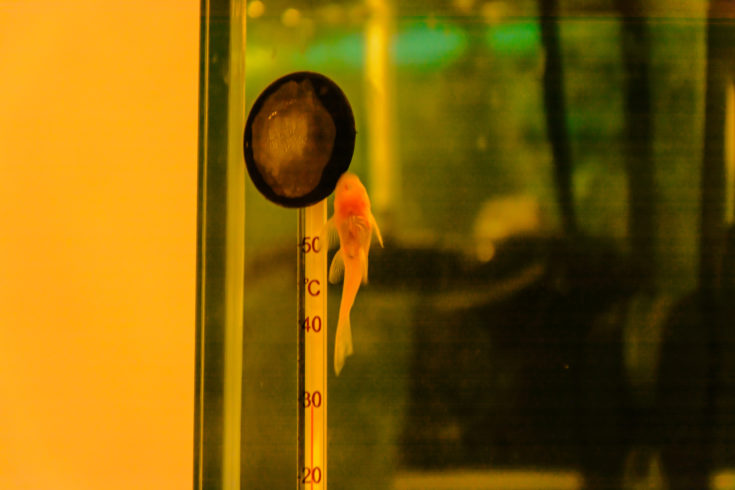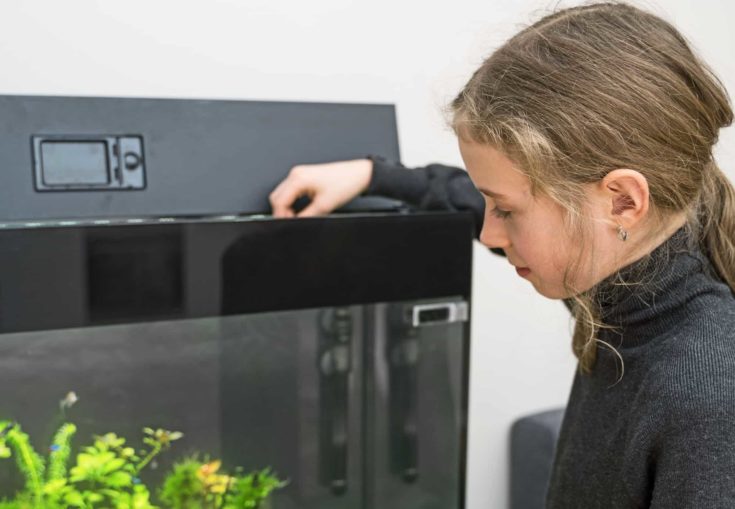The Iridescent Shark is one of the most impressive freshwater fish in the aquarium trade, but did you know these shiny schoolers can grow from 3-inches to over 4-feet long at maturity? Don’t make the mistake of getting a young fish who’ll outgrow your tank; here’s everything you need to know to keep a Giant Shark!
What Kind of Fish Are Iridescent Sharks?
Despite their shark-like appearance and massive size, Iridescent Sharks (Pangasianodon hypophthalmus) are actually a species of scaleless freshwater catfish in the Pangasiidae family. So why are these timid and somewhat skittish fish only recommended for advanced or experienced aquarists?

Iridescent Sharks are challenging to maintain in an aquarium because of their large size, high activity level and a few behavioral quirks they exhibit in captivity. The truth is, they’re a better option for heated ponds rather than aquariums, and few hobbyists have tanks suitable for a single adult shark, let alone a group:
- While you can raise juvenile sharks in a 100-gallon aquarium, they’ll grow more than a foot in length over their first year and will quickly need a bigger home.
- They’re very active daytime swimmers; you’ll need at least 300-gallons capacity for one adult, and 150-gallons for each additional shark.
- Iridescent Sharks are easily startled and can injure themselves by running headlong into the aquarium. Their tanks are best approached slowly and should be located in quiet, low-traffic areas.
While the Iridescent may not be the ideal freshwater shark for most of us, they’re fascinating to observe and definitely worth aspiring to, so let’s take a deeper look at these big, interesting catfish!
Natural History and Habitat
Iridescent Catfish are one of about 30 species of pangasiussharks found in waterways across South and Southeast Asia. Native to the deep waters of the Mekong River and Chao Phraya River system in Thailand, these sharks are also raised in commercial fish ponds in Vietnam and sold as a cheap source of protein:
- Iridescent Sharks inhabit deep rivers with a moderate current, and mostly swim in the middle of the water column as they look for food.
- These sharks are omnivorous, but prefer different foods depending on their stage of development. Juvenile Sharks feed heavily on meaty, protein-rich crustaceans, worms, insects and larvae/eggs, while adults prefer to eat more plant materials and algae, along with smaller animals.
- Iridescents have poor eyesight and live in murky rivers or ponds. They rely on the sensitive barbells around their snout to help them find scraps and live foods.
As an aquarium export and valuable source of food, Iridescents have picked up quite a few nicknames, and you may see them for sale in various parts of the world as freshwater Blue Sharks or Blue Catfish, Siamese Sharks, Sutchi Catfish, and Emperor Sharks, while their meat is sold in Vietnam under the name “swai.”
Iridescent Sharks: Size, Appearance and Growth Rates
We don’t actually know a lot about shark growth rates or how quickly they mature when kept in aquariums. Iridescent Sharks are often started in tanks that are too small and fail to thrive, or have to be rehomed when they get too big, so there’s not many examples to follow:
- Juvenile fish are usually around 2.5 to 4-inches in length at the time of sale, and with a spacious starter tank and meaty diet they should reach around a foot in length within a year.
- We’re not sure how long it takes these fish to reach their adult size, either, since aquarium-raised fish tend to be smaller than those raised in ponds, and usually top out at around 3-feet, rather than reaching the maximum of 4.3 feet seen in wild adults.
Juveniles Look Different From Adult Sharks
Iridescent catfish have a small head and wide mouth, with teeth attached to their jaw and other facial structures. They have large eyes, two pairs of barbells, a “shark-like” 6-rayed dorsal fin, a prominent pointed anal fin and a forked caudal fin. One really interesting thing about these scaleless catfish is they look different as juveniles, especially the colors of their skin:
- Young fish have an iridescent blue tint that really catches the eye (and gives them the name Iridescent), and look amazing in groups as they school.
- Juvenile sharks also have two black lines running down their sides; one over their lateral line and another just beneath it.
- Adult Iridescents lose the black lines and brighter colors (and many of their teeth), and mature to a silver-grey shade, sometimes with a greenish tint, with dark-colored fins.
- There’s also an albino Iridescent Shark morph; they look pinkish as juveniles and lack the black stripes, but mature into a beautiful white-colored adult shark!
Iridescent Shark Lifespan
Iridescent Sharks can live for 15 to 20 years in captivity, but the sad truth is the majority of young fish only survive for a few years due to inadequate conditions. Cramped aquariums, aggressive tank mates, dirty water and poor diets all take their toll on these sensitive catfish and reduce their lifespans.
Behavior and Temperament
Iridescent Sharks are timid and rather shy, and their behaviors change as they mature. Juvenile sharks prefer to live in groups and often school together for safety, which is simply a beautiful sight. Once they reach adulthood they become a little less social and more independent.
As active and strong swimmers, sharks need a lot of open room in the middle of the tank, and they’ll also swim to the top or scavenge through your substrate looking for food. They’re usually easy-going, but they have an impressive startle response that can send them reeling into your tank or equipment, so always approach slowly.
How to Care for Your Iridescent Shark Tank
The good news is that it’s not hard to maintain Iridescent sharks; the challenging parts are establishing a tank or pond big enough to house them for 20 years and keeping up on the weekly water changes!
Tank Set-up and Habitat Requirements
The ideal set-up for an adult Iridescent isn’t an aquarium at all, but a huge, heated pond. Since most of us can’t afford to put in a 10,000+ gallon pond, though, let’s talk about how to set up a great shark tank inside your home.
Ideal Aquarium Size for Sharks
If you’re going to begin with a group of young sharks, it’s best to get 5 similar-sized fish and start them in a tank that’s at least 100 gallons, or bigger if you’d like to keep them with tank mates. Young fish are active schoolers and will dominate the middle, and cramped conditions will increase their stress.

Once your fish are around a year old or nearing 1-foot in length, it’s time to upgrade. The ideal size will depend on how many adults you’re keeping. Allow 300 gallons of capacity for the first adult and 150 more for each additional shark. For a tank with 5 iridescent Sharks, you’ll need a 900 to 1000 gallon aquarium!
Aquarium Location is Critical!
Since sharks have poor eyesight and startle easily, you’ll want to locate your tank in a quiet part of your home, away from noisy equipment and high traffic areas. A shark tank isn’t a good choice for an active family room or kitchen. Always approach the tank slowly and allow the fish to know you’re there so you don’t scare them.
Substrate and Lighting
It’s best to mimic the shark’s natural environment when setting up your tank since that will reduce their injury potential and help them feel at home. Opt for a soft aquatic soil instead of sand or aquarium gravel, since that’s similar to a muddy river or pond. They don’t care for really bright lights, so you can also use floating plants to shade parts of your tank.
Water and Temperature Parameters

Iridescent Catfish prefer stable and warm conditions and don’t like it when their water parameters shift suddenly. Easily startled, sharks can panic and damage submersible heaters and other internal equipment, so it’s best to use an in-line or external heater instead. Their preferred water conditions are:
- Temperature 72 to 79°F
- pH 6.5 to 7.5
- Not especially sensitive to water hardness; 2 to 20 dGH
Filtration and Aeration
As scaleless catfish, sharks are very sensitive to their water quality and prefer to swim in moderate currents. They produce a lot of waste and can quickly overwhelm an aquarium with inadequate filtration. You’re best bet is to aim for robust mechanical, chemical and biological filtration by using several systems in tandem:
- You’ll need at least 1 (and possibly more) powered canister or external pond filtration systems that can hold several types of filter media, and should be able to turnover or filter at least twice your tank’s capacity every hour.

- A sump filter is especially beneficial for shark aquariums, since they’ll help regulate your tank’s nitrogen cycle and break down some of their waste products into a safer form.
- You’ll want to keep your water’s oxygen levels high with several air stones or bubbling devices, so get an air pump that can power several air bubblers at once.
Plants and Hardscape (Decor)
Active fish like Iridescents need a lot of open areas to swim and look for food, and they’re so big and strong they can send decor flying around the tank if it’s loosely placed or piled. It’s best to limit your hardscaping and plants to the edges and corners of your shark tank, and leave the center areas open:
- Natural hardscape like rocks, boulders, and driftwood should be permanently secured in your tank with silicone sealant or fasteners as you’re setting it up. Unsecured piles of rocks and branches could shatter your aquarium’s glass if a shark knocks it over!

- These omnivorous fish may snack on your plants when they’re young and WILL eat them as adults, so you may want to replant fast-growing types like hornwort as a shark snack food
Shark Tank Maintenance
Emperor Sharks are very messy fish, and with their huge appetites, they produce a lot of waste. They’re also very sensitive to ammonia and other toxins since they’re scaleless catfish. It’s best to do weekly 25% water changes on shark tanks, even if you have a premium filtration system.
Since you’ll be swapping out anywhere from 75 to 250 gallons a week (for 300 to 1000 gallon set-ups), you’ll probably want to invest in an electric water pump and vacuum system, like those used for saltwater or reef aquariums, rather than using the classic hose-and-bucket method.
Feeding Your Sharks
Iridescent Sharks are omnivorous and have huge appetites, but prefer different foods depending on their stage of maturity. You’ll want to feed your sharks several meals a day, and as much food as they can consume in 3 to 5 minutes. For the first year, offer your juvenile sharks meaty foods and high-protein treats :

- Use premium floating catfish pellets or flakes as their primary diet.
- Supplement with daily treats of live/frozen brine shrimp, bloodworms, larvae, and insects like flies and small crickets.
As your shark’s mature and reach their adult size (and lose teeth), shift towards offering more veggies and plant foods:
- Rotate between the omnivorous catfish flakes and veggie-based algae wafers or flakes, spirulina pellets, live plants, and fresh blanched veggies like zucchini, cucumber, carrots, and peas.
- Supplement with larger meaty treats several times a week. You can offer brine shrimp and bloodworms, but also consider earth, meal and waxworms.
- You can also offer live fish and shrimp, but it’s best to quarantine them first to reduce the chances of introducing aquatic diseases or parasites into your tank.
Iridescent Shark Tank Mates
The best tank mates for these big, peaceful fish are other Iridescent sharks, and juveniles in particular, prefer to be in a group from 3 to 5. Adult sharks are less social and don’t school together, but still enjoy company. It can be tricky to match these sharks with appropriate buddies, since they’ll outgrow most other fish.
Avoid keeping sharks with smaller fish like tetras and barbs, or edible snails and shrimp. Large, aggressive fish like cichlids may pick on your sharks, but are among the better options. You’ll have to keep an eye on the situation and remove or rehome any problem fish. Some of the best tank mates include:
- Large plecostomus like the Common and Rubber (but not the smaller Bristlenose or Rubber Lipped plecos)
- Synodontis catfish
- Cichlids like the Pantano, Oscar, Texas or Salvin’s
- Silver Dollars and Pacu
- Kissing Gourami
- Imperial Flower Loach (Leptobotia elongata)
- Bichir or reedfish
- Fire Eels
Breeding
Iridescent Sharks won’t breed in captivity, so commercial breeders in Asia inject fish with hormones to induce egg production and spawning in industrial ponds. Migration and season changes probably play a role in wild shark reproduction, but we really don’t know what triggers them to spawn naturally.
Health Concerns
Sharks are very sensitive fish and easily stressed, and stress can lower their immune system and predispose them to illnesses. It’s important to maintain good water quality since they can’t tolerate detectable levels of ammonia or nitrates, but that’s not the only thing to keep an eye on:
- Avoid startling your fish, since this causes a spike in adrenaline and a release of stress hormones, not to mention they can hurt themselves in a panic. Even a dog or toddler running by their tank a few times a day or the sound of your thermostat kicking on could be a problem for these skittish catfish!
- Be sure your sharks don’t get harassed or bullied by aggressive tank mates, and remove problem fish immediately.
- Sharks are facultative air breathers and can “gulp air” at the surface if the oxygen in their water is too low. But they’ll also display this behavior when they’re not feeling well, so consider it a warning sign.
The other downside to keeping scaleless Iridescent catfish is they’re more susceptible to aquatic diseases and parasites, especially skin funguses and the protozoan that causes ich. To reduce the chance of outbreaks in your tank:
- Quarantine new plants and animals in another aquarium for a couple of weeks, especially animals that often carry diseases like feeder fish.
- Use UV sanitizers to reduce the pathogens floating in your water column.
Iridescent Shark Tank: Basic Equipment and Supply List
Here’s a list of the basic supplies and equipment you’ll need to maintain a group of five adult Iridescents and their tank mates. Consider installing a permanent backdrop, and remember to attach the hardscape to the tank with silicone sealant or fasteners!
For the set-up, you’ll need to buy:

- 1000+ gallon aquarium with stand, hood or cover and LED lights
- Appropriate canister filters or external pond filtration system
- Sump filter and powerhead or pump for water return
- Several temperature gauges
- In-line or external heater(s)
- Aquatic soil or other soft substrate
- Air stones and bubbling devices with an air pump and plastic tubing
- Hardscapes such as rocks, boulders, driftwood and branches
- Variety of live plants
- Filter media
- UV sanitizer(s)
- Water conditioner
- Water testing kit (pH, ammonia/nitrates)
- Hoses, buckets and ideally an electric water pump for water changes
To feed your sharks, you’ll need:
- Omnivorous catfish pellets or flakes
- Algae, spirulina and freshly blanched veggies
- Variety of live/frozen foods like brine shrimp, bloodworms, insects and feeder fish
Common Name (species)
Iridescent Shark, Blue Catfish, Siamese Shark, Sutchi Catfish, Emperor Shark (Pangasianodon hypophthalmus)
Family
Pangasiidae
Origin
Thailand
Diet
Omnivore; preferred diet shifts at maturity
Feeding
Primary diet of omnivorous catfish flakes supplemented with plant materials, algae and spirulina. Offer treats of live/frozen brine shrimp, bloodworms, insects, earthworms and feeder fish or shrimp
Care Level
Advanced
Activity
Very active and powerful swimmer
Temperament
Peaceful, shy and timid
Tank Level
Middle, but uses the entire tank
Minimum Tank Size
300 gallons for 1 shark; allow 150 gallons for each additional
Temperature Range
72 to 79°F
Water Hardness
2 to 20 dGH
pH Range
6.5 to 7.5
Filtration/Flow Rate
Moderate current along in the middle of the water column
Breeding
Does not breed naturally in captivity
Compatibility
Best with other Iridescents, but often does well with large fish like plecos, cichlids and other catfish if aggression is closely monitored. Avoid smaller fish and crustaceans
OK for Planted Tanks?
Yes, but they will eat the plants, so opt for fast-growing species like Hornwort and replant frequently
Conclusion
Iridescent Sharks are an expensive and challenging fish that’s best left to advanced fish keepers, but that doesn’t mean you can’t dream about setting up an amazing Giant Shark Tank with your lottery winnings! Share your sharky aspirations in the comments below, or join our aquatic community online!
I have a 18 inch iridescent. And two 20 inch plecos. In a 175 gallon. And there doing great. My shark does have a bad attitude. Its a female.